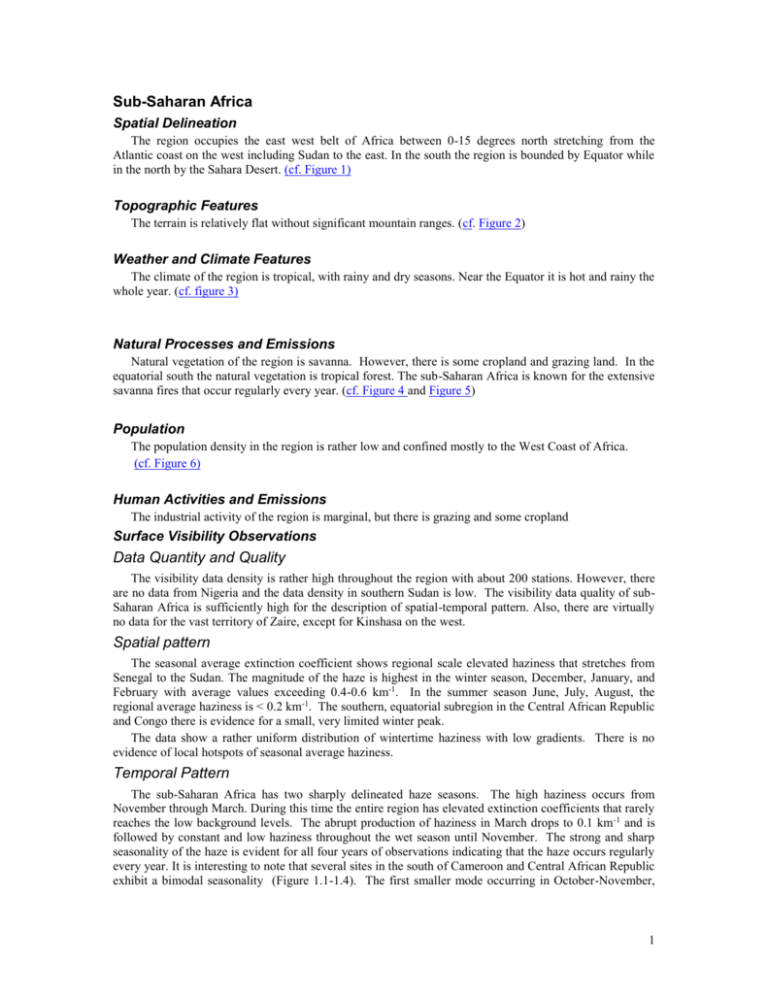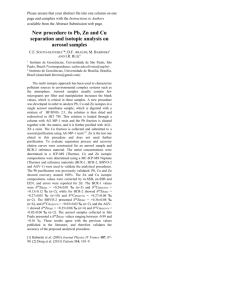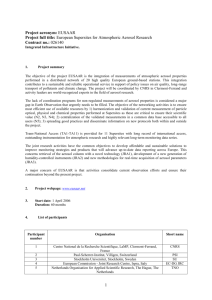Sub-SaharianAfrica
advertisement

Sub-Saharan Africa Spatial Delineation The region occupies the east west belt of Africa between 0-15 degrees north stretching from the Atlantic coast on the west including Sudan to the east. In the south the region is bounded by Equator while in the north by the Sahara Desert. (cf. Figure 1) Topographic Features The terrain is relatively flat without significant mountain ranges. (cf. Figure 2) Weather and Climate Features The climate of the region is tropical, with rainy and dry seasons. Near the Equator it is hot and rainy the whole year. (cf. figure 3) Natural Processes and Emissions Natural vegetation of the region is savanna. However, there is some cropland and grazing land. In the equatorial south the natural vegetation is tropical forest. The sub-Saharan Africa is known for the extensive savanna fires that occur regularly every year. (cf. Figure 4 and Figure 5) Population The population density in the region is rather low and confined mostly to the West Coast of Africa. (cf. Figure 6) Human Activities and Emissions The industrial activity of the region is marginal, but there is grazing and some cropland Surface Visibility Observations Data Quantity and Quality The visibility data density is rather high throughout the region with about 200 stations. However, there are no data from Nigeria and the data density in southern Sudan is low. The visibility data quality of subSaharan Africa is sufficiently high for the description of spatial-temporal pattern. Also, there are virtually no data for the vast territory of Zaire, except for Kinshasa on the west. Spatial pattern The seasonal average extinction coefficient shows regional scale elevated haziness that stretches from Senegal to the Sudan. The magnitude of the haze is highest in the winter season, December, January, and February with average values exceeding 0.4-0.6 km-1. In the summer season June, July, August, the regional average haziness is < 0.2 km-1. The southern, equatorial subregion in the Central African Republic and Congo there is evidence for a small, very limited winter peak. The data show a rather uniform distribution of wintertime haziness with low gradients. There is no evidence of local hotspots of seasonal average haziness. Temporal Pattern The sub-Saharan Africa has two sharply delineated haze seasons. The high haziness occurs from November through March. During this time the entire region has elevated extinction coefficients that rarely reaches the low background levels. The abrupt production of haziness in March drops to 0.1 km -1 and is followed by constant and low haziness throughout the wet season until November. The strong and sharp seasonality of the haze is evident for all four years of observations indicating that the haze occurs regularly every year. It is interesting to note that several sites in the south of Cameroon and Central African Republic exhibit a bimodal seasonality (Figure 1.1-1.4). The first smaller mode occurring in October-November, 1 and the second larger peak in February. It is probable that an explanation for this behavior lies in the seasonality of the dry and wet periods. During the hazy winter season the episodic peaks in the region reach 1-2 km-1 two or three times a month. The unique feature of the aerosol event is that they tend to last from a week to ten days. Even when the haze levels drop they do not reach their background level. There is a coincidence of the peaks over the adjacent sites that are 500 km apart, which indicates the regional character of these aerosol events. Over the southern equatorial subregion, the winter peaks are greatly diminished in magnitude and frequency. Evidently, tropical forest over Central Africa is rather haze-free. Predominant Aerosol Type The predominant aerosol type of the region is believed to be smoke from the biomass burning arising of the thousands savanna fires. It is conceivable that in the springtime there are incursions of Sahara dust events from the north Summary The sub-Saharan savanna region is among most significant biomass smoke aerosol source regions of the world. The Biomass burning and associated smoke is confined to the November-March, half of the year, while the other half of the year is virtually aerosol free. During the combustion season the haze episode levels reach 1-2 km-1 and they last a rather long time from a week or ten days. The aerosol type of the region is believed to be primarily savanna fire aerosol with possible, rare incursions of Sahara dust from the north. Figure 1.1. The sites in Togo and Benin exhibit a bimodal Figure 1.2. During the hazy winter season the episodic peaks in the seasonality. The first mode occurs in October-November and the region reach 1-3 km-1 two or three times a month. The unique second mode in February. feature of the aerosol events is that they tend to last from a week to ten days. Figure 1.3. The sites in Cameroon and Central African Republic Figure 1.4. During the hazy winter season the episodic peaks in the 2 exhibit a bimodal seasonality. The first smaller mode occurs in October-November and the second peak in February. region reach 0.2-0.6 km-1 one or two times a month. episodes tend to last from a week to ten days. 3 The





